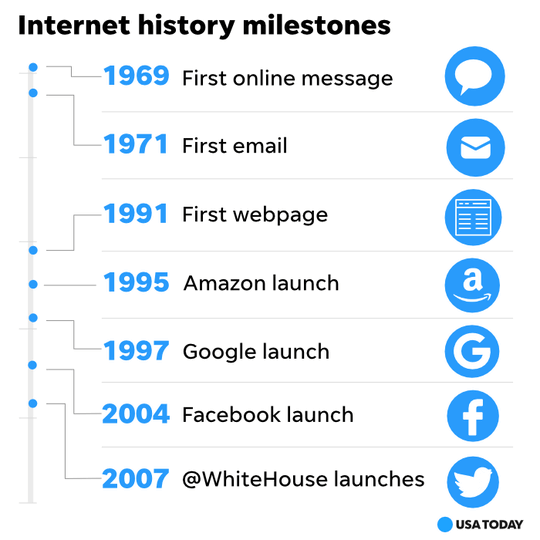Internet Turns 50, Just Might Catch On

My parents argued the Internet was a fad. They may still be right.
Media outlets have settled on October 29 as the official birthday of the Internet. It’s the day that Leonard Kleinrock at UCLA sent a message over a two-computer network (the other end being a computer at Stanford Research Institute) with Charley Kline manning the UCLA keyboard and Bill Duvall on the Stanford site.
The computer carrying the first ever transmission on the Internet (“LOGIN”) crashed after only two letters (“LO”). I believe Kline actually typed an “L” for the third letter (instead of “G”). Prove me wrong.

On September 2, 1969, two computers were connected with a 15-foot cable and passed data back and forth. That was a precursor to the networking that happened a month later, but is not generally regarded as the birth of the Internet. Just as neither the first email message (1971) nor the first web browser (1993) are considered the birth of the Internet.
While the World Wide Web is not the Internet, it is the platform built atop the Internet with which people are most familiar. The World Wide Web Foundation is using today to promote its effort to protect the web overall:
We urgently need an ambitious, coordinated effort to tackle the threats facing the internet and the web, and make sure that everyone is able to access the benefits of digital technology. Next month, we’ll publish the Contract for the Web — a plan created by experts and individuals from across the world to make sure our online world is safe, empowering and genuinely for everyone.
UCLA has been running a live stream day-long discussion of the Internet:
Along with the trailblazing Arpanet pioneers, today’s leading technologists and visionaries will discuss the genesis, current state and future aspirations of our connected world.
Related
- Opinion: 50 years ago, I helped invent the internet. How did it go so wrong? by Leonard Kleinrock.
- On the 50th anniversary of the birth of the internet, technologists balance optimism and warnings at NBC News.
- How We Misremember the Internet’s Origins at New Republic.
- Internet Turns 40, Just Might Catch On by me.
Happy 50th birthday, Internet. Love, (a still skeptical and slightly confused) Katie. #Internet50 #InternetDay
📹 footage c/o @TODAYshow pic.twitter.com/RdBWsemJNx
Opening image uses a pair of Lear-Siegler ADM5s from the Museum of Computer history in La Défense, Paris. The source computer image is by ntr23 and is licensed CC BY-NC-SA 2.0.
Also…
- The World Wide Web turned 30 a few months ago,
- the W3C turned 25 earlier this month,
- the evolt.org browser archive turned 20 a couple months ago, and
- Firefox turns 15 in November,
- HTML5 turned 5 yesterday.
Leave a Comment or Response